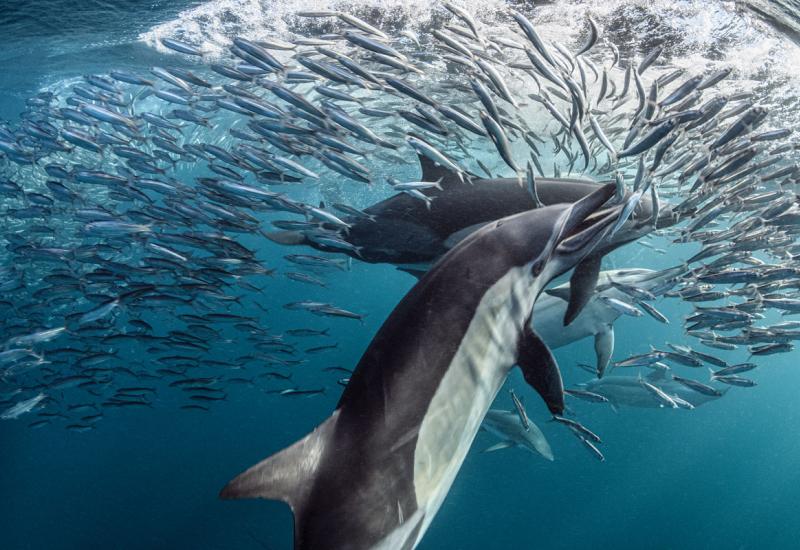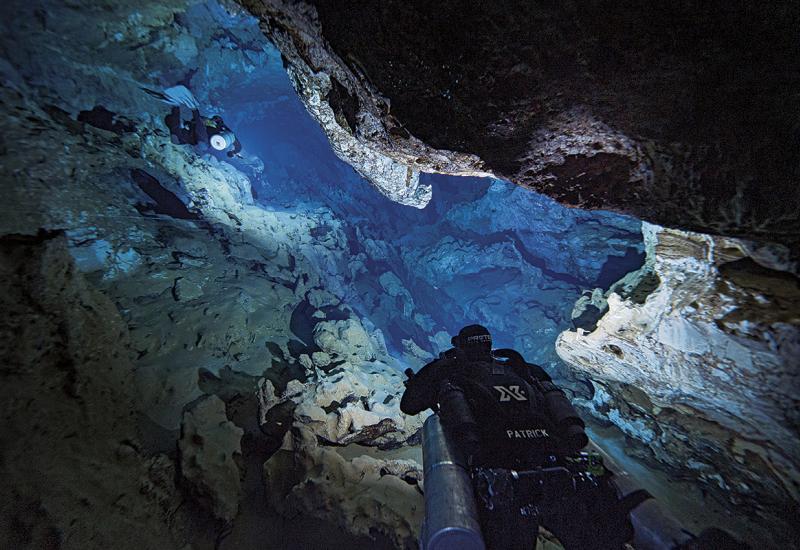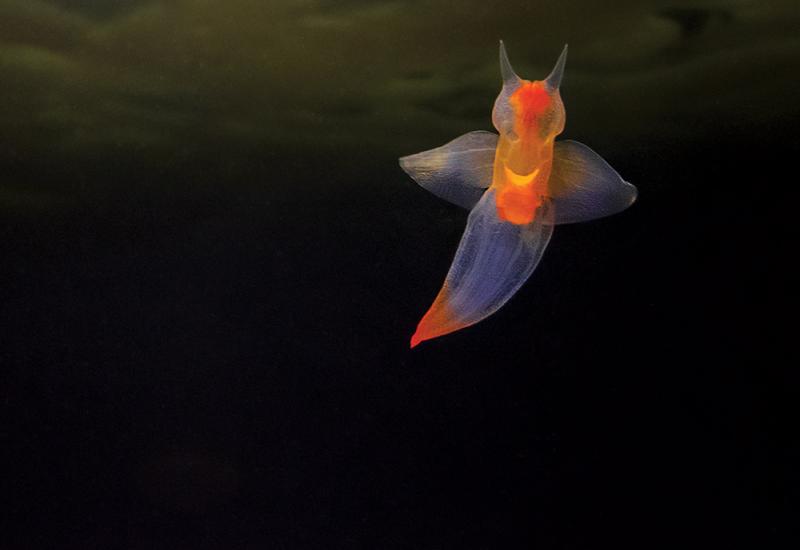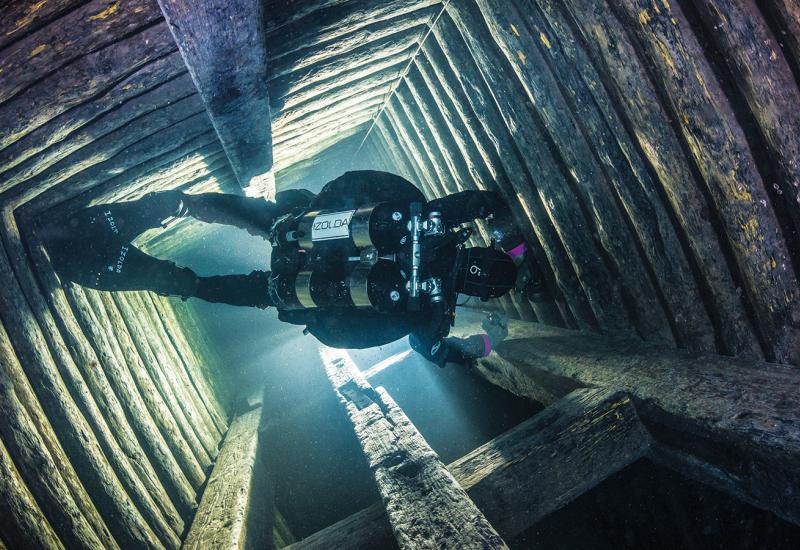The Silent Fleet of Scapa Flow: Scuba Diving amid World War History
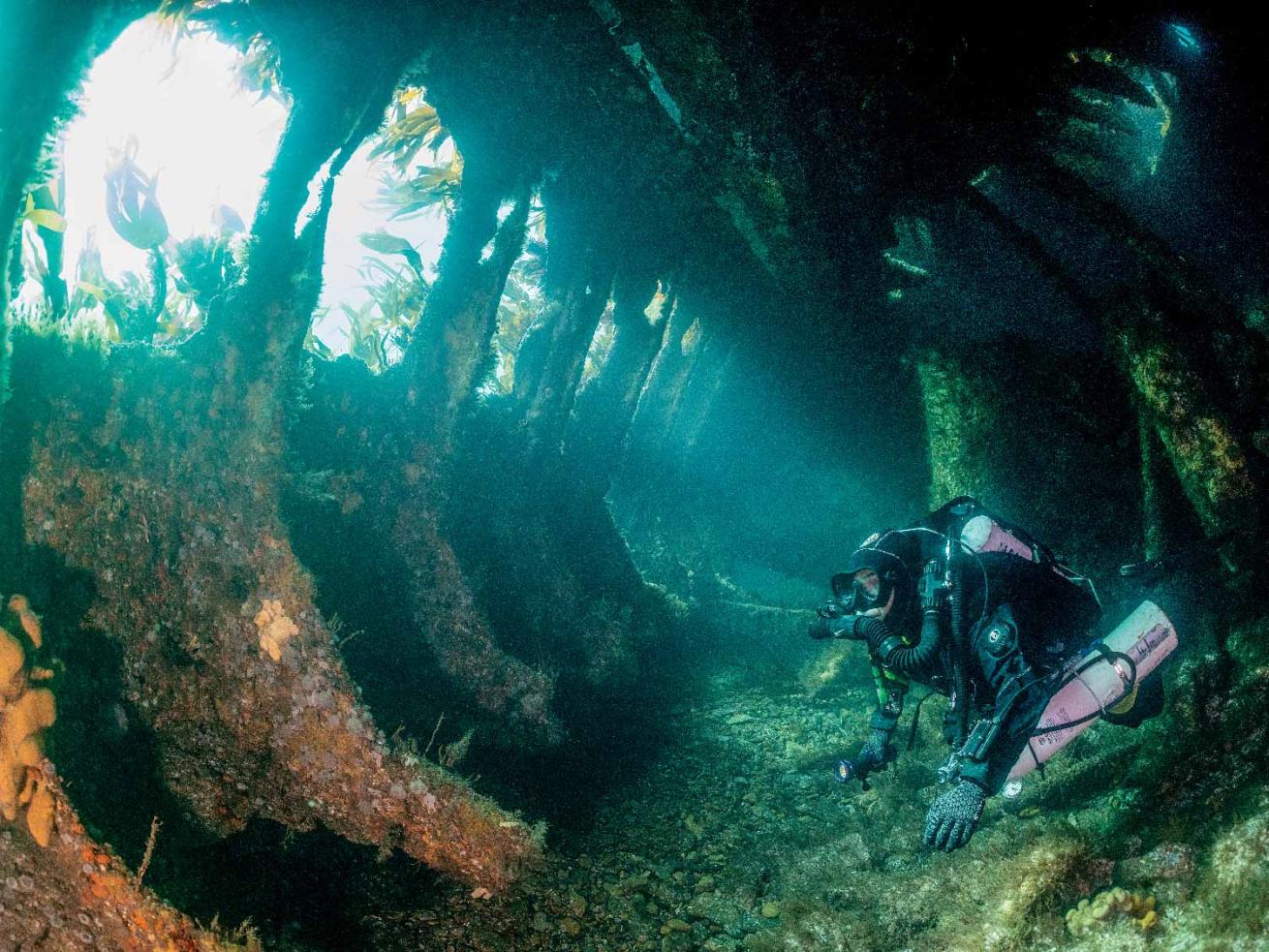
Steve JonesA rebreather diver inside Tabarka, a “block ship” sunk in Scapa Flow.
Descending into an emerald void, I slow as the appearance of a hull surprises me. It is massive, beyond anything I’d imagined. I hover above this metal desert, trying to comprehend the scene before heading over the side into the beckoning darkness. We drop another 60 feet into a tangle of twisted metal, our powerful lamps scanning for familiar shapes in an upside-down world, for this ship rolled as it sank, pulled over by the weight of thick deck armor and heavy weaponry. The distinct outline of a gun barrel emerges, menacing, as if it were sailing out of fog, and suddenly the ship reveals itself. This is the mighty Markgraf, which at the time of its sinking was one of the most powerful battleships ever created.
Behemoths
The sheer scale of this ship must be seen to be believed. Displacing more than 28,000 tons and measuring over 480 feet in length, there is so much to explore, more than enough for multiple dives. Lying at 145 feet, the SMS Markgraf is the deepest of the German fleet wrecks here, a factor that may have helped protect it from extensive salvage, thus preserving one of the finest divable battleship wrecks in the world.
The starboard side, propped up by the superstructure, is where the most interest lies; here we soon find more casemate guns, reminding us that this ship bristled with weaponry that could take on any opponent. There were 14 of these smaller 5.9-inch guns, used primarily for defense; the offense came from the 10 main guns, which could hurl huge 900-pound shells onto targets 13 miles away. While buried and inaccessible on this wreck, they are very much within reach on a nearby sister ship.
There are few wrecks in the world where divers can see the iconic main guns of a battleship; this fact alone makes Kronprinz Wilhelm a favorite among wreck aficionados. As we near the seabed, my dive partner, Bob Anderson, the affable captain of our boat, beckons me to follow him under the ship.
Acutely aware that I have a battleship above my head, I move with extreme care to avoid disturbing sediment, yet my apprehension dissipates as the enormous 12-inch gun emplacements appear, an awe-inspiring view of weapons once fired in anger. All three German battleships in Scapa Flow saw serious action that included the Battle of Jutland, where the full might of the British and German fleets faced off in one of the most momentous sea battles in history. These very guns fired some of the 264 shells expended by this vessel during an encounter that cost the lives of thousands of sailors on each side.
We emerge and head forward, finding the spotting tower that would have helped guide those shells to their targets with deadly accuracy, before we ascend the anemone-covered hull to within 40 feet of the surface, whittling away our decompression stops along the way.
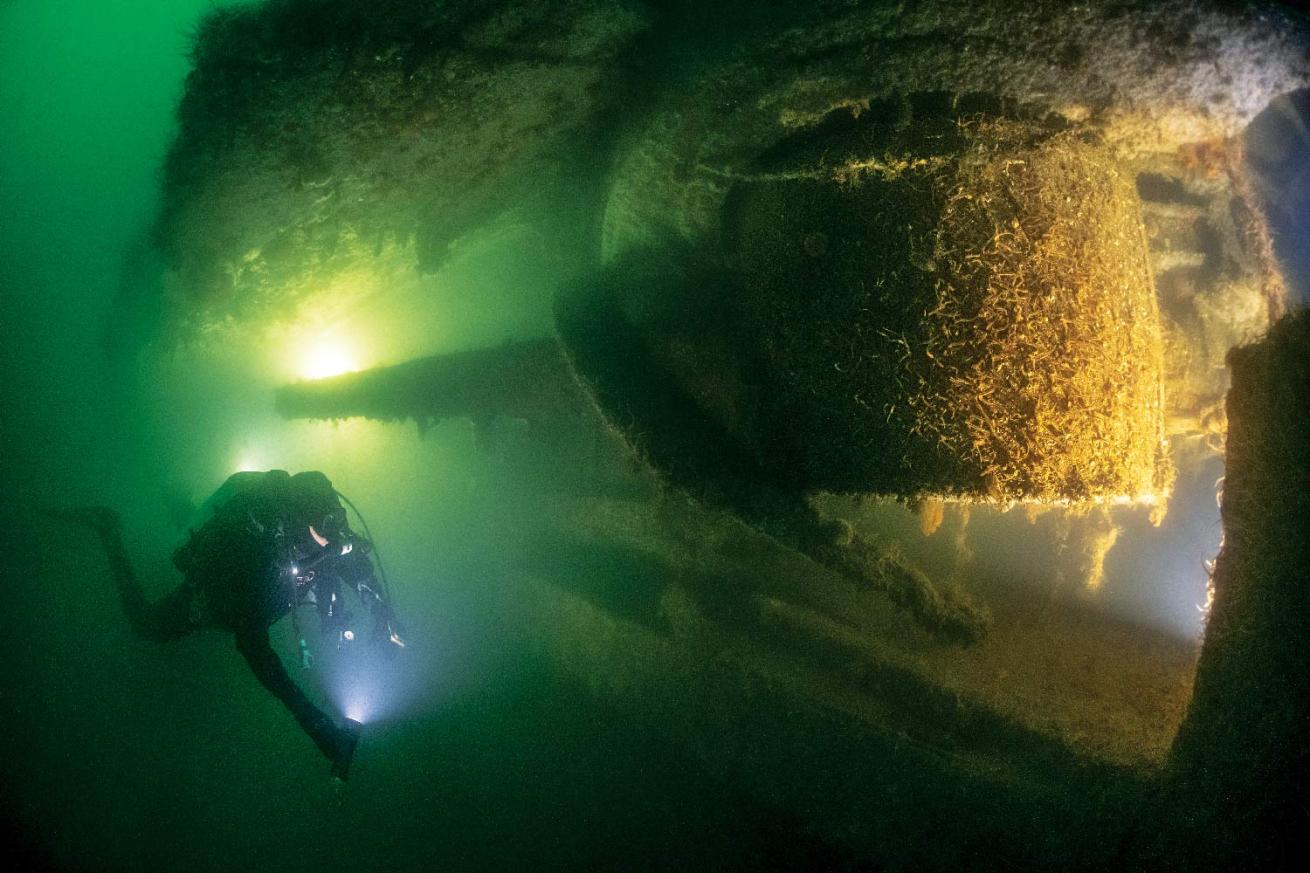
Steve JonesA diver illuminates the forward 5.9-inch casemate gun on the wreck of the Markgraf.
The End of It All
Scapa Flow—a strategically important natural harbor in the heart of the Orkney Islands—has seen its fair share of tragedy, including the World War II torpedoing of HMS Royal Oak, where 833 sailors lost their lives. However, it was immediately after World War I that fate transformed this into one of the world’s great wreck-diving destinations.
Following the November 1918 armistice, 74 ships of the Kaiserliche Marine were interned here. But as final peace proved elusive, the German fleet commander, Rear Admiral Ludwig von Reuter, became fearful the British would seize his ships, and formulated a plan to thwart such an outcome.
Finally, Germany was given a deadline to accept peace terms by June 21, 1919, or war would resume. That morning, Von Reuter, in full dress uniform, gave the order to scuttle his fleet. Meticulous preparation by his crews ensured success; by late afternoon, where there was once a battle fleet was now floating debris. Fifty-two ships were on the bottom, the remainder beached by the Royal Navy. Sixteen German sailors were wounded and nine killed during skirmishes, the last casualties of World War I.
The armistice had in fact been extended by two days, but Von Reuter later claimed he had not known that. His British counterpart suggested otherwise. Both men stood by their stories for the rest of their lives, with Von Reuter resolute that any British officer would have done as he had, faced with similar circumstances. As for the men who sank their own fleet, they were considered to have committed an act of war during an armistice and were interned as prisoners of war until January 1920, the last World War I POWs to return home, where they received a hero’s welcome. The war officially ended on June 28, 1919, just seven days after the momentous events that sent nearly an entire fleet to the seabed.
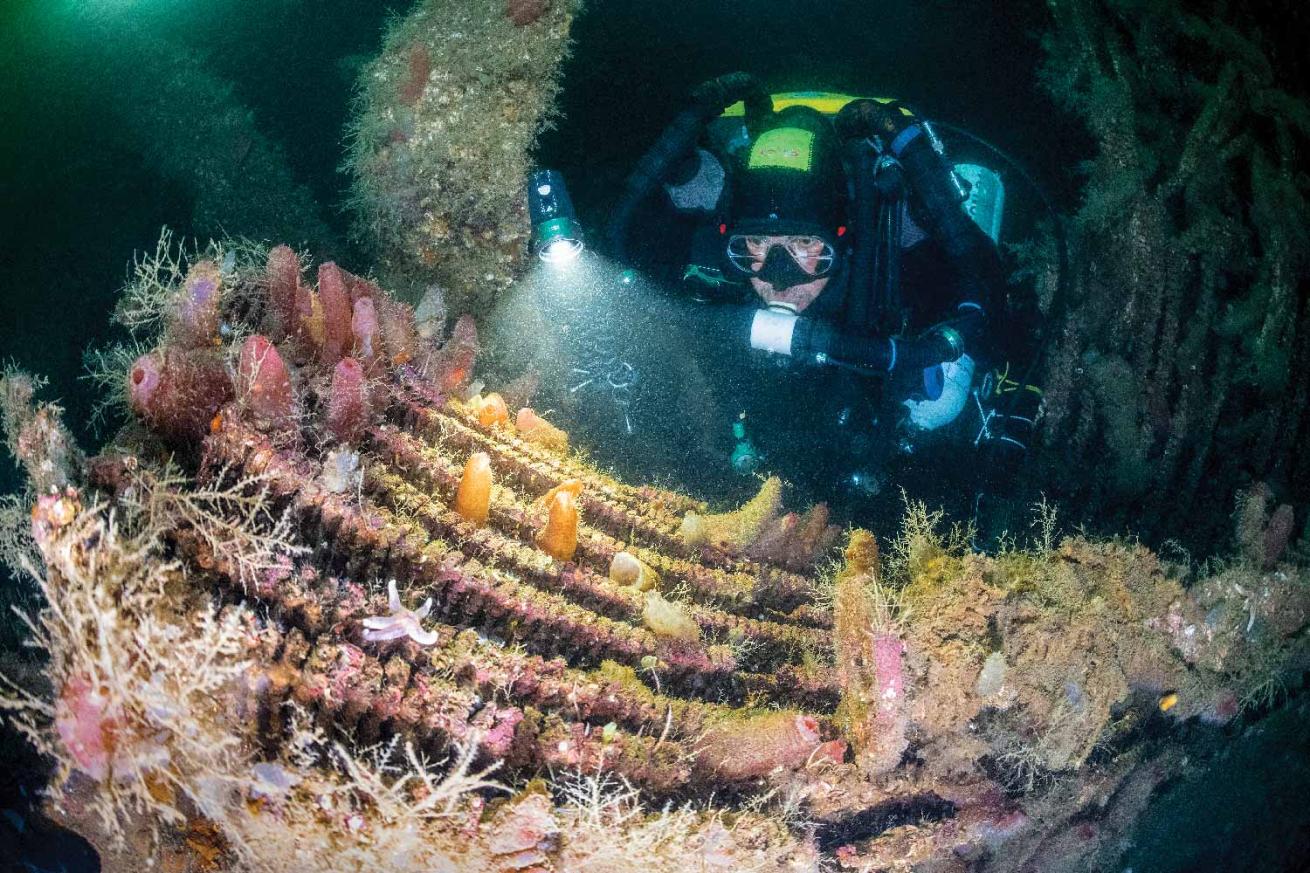
Steve JonesA rebreather diver examines the turbine blades on the SMS König.
Something for Everyone
The SMS König is the third German battleship we visit at Scapa Flow; due to heavy salvage blasting, it needs careful predive route planning if we are to get the best out of it. Being the least dived of the battleships, marine life thrives here, evidenced by the schools of pollock that greet us at the bottom of the line. After a short swim, we arrive at a turbine that contributed to the enormous 43,000 horsepower the engines produced to propel this fast ship to 21 knots.
Dropping into deeper water, Anderson points out the precise dovetail joints of the armored citadel, the 12-inch-thick rectangular casing of steel that protected critical core areas. We finally arrive at the base of one of the barbettes, an armored housing in which a main gun rotated. Salvage has exposed much of the inner workings of this wreck; by following my experienced guide, the dive has become an educational lesson in battleship design.
Vulnerable to submarine attack, the approaches to Scapa Flow were fortified with defenses, the simplest of which were deliberately sunk ships barricading the entrances. These “block ships” lie in clear-water channels and are well worth exploring, some of which allow you to spend the entire dive inside them. Their shallow depth also helps keep in check the inevitable nitrogen accumulation from deeper dives, ensuring you can still maximize time on some of the most endearing wrecks: the cruisers. Less-intense dives than the much-larger battleships, the four German cruisers lie on their sides, so you don’t need to go as deep to see the best of them. Consequently, they appeal to a wider range of diving experience; the shallowest is the SMS Karlsruhe, a 367-foot-long light cruiser lying at 80 feet.
Extensively blasted during salvage, what this wreck lacks in aesthetics it makes up for with a glimpse of the inner workings of the ship. Starting at the bow, we encounter massive anchors, their chains still wrapped around the huge capstans. The bow has broken off and lies on the seabed, now an oasis for brittle stars and wrasse. Two of the main 5.9-inch guns lie nearby, defiantly pointing forward.
We head aft, passing the remains of the armored control tower—the command post during battle instead of the more vulnerable bridge—before we reach the boiler room, which generated enough steam pressure to propel this ship to 27 knots, fast even by today’s standards.
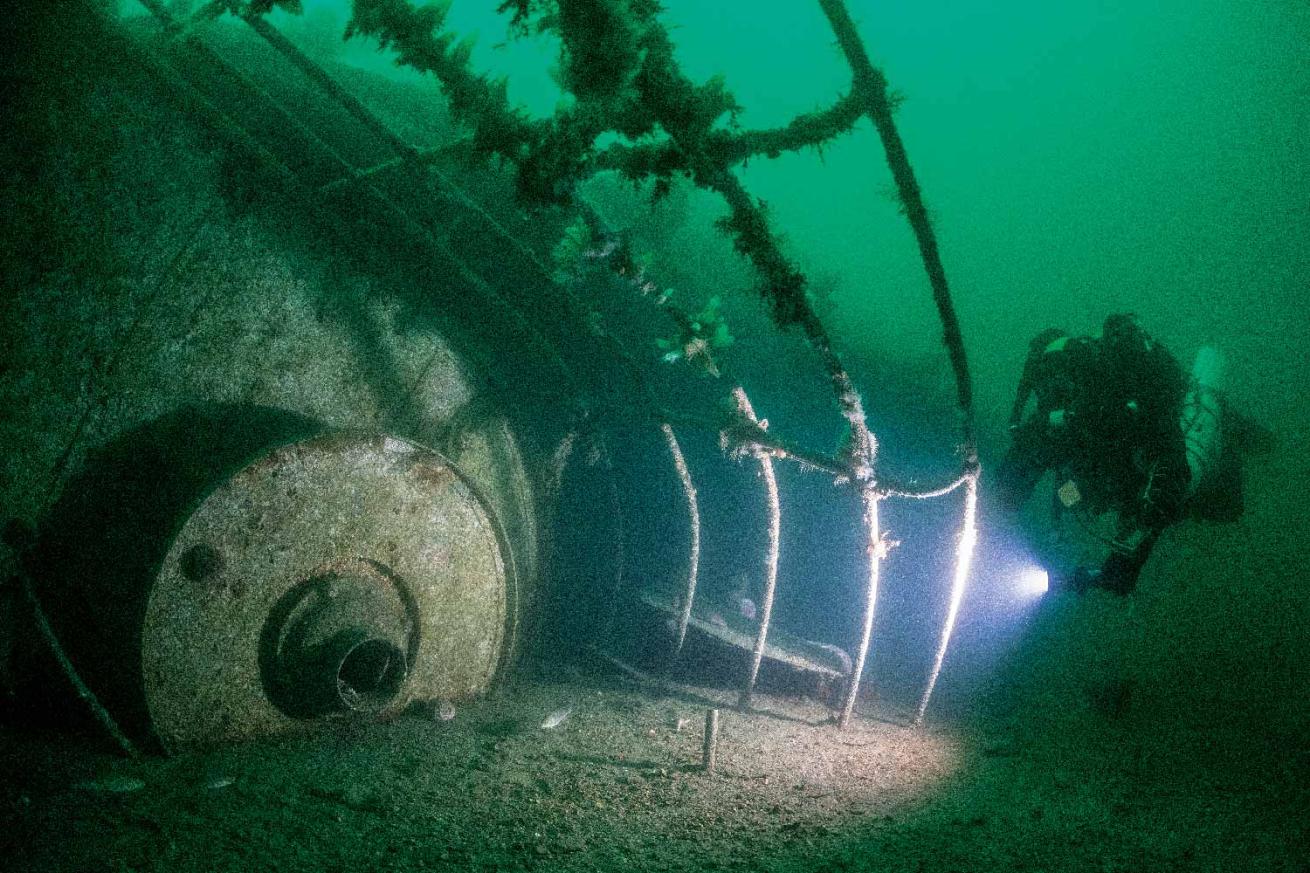
Steve JonesA diver approaches the guardrail atop the SMS Brummer, now lying on its side.
Reclaimed by Time
The Dresden lies on a slope, 80 feet at the bow yet 125 feet at the stern. The wreck’s deterioration is obvious; as it slowly turns, sinking into the seabed, gravity peels away the forward deck. Nonetheless, this 6,190-ton warship remains an imposing sight.
As we swim into deeper water, we reach where the bridge once stood. Nearby, a solitary bathtub lies in the sand, poignantly resting near the officer’s accommodations. Similarly, the forward deck is also peeling away on the Brummer, which is otherwise in good condition with lots to see, making it a firm favorite with divers. This mine-laying cruiser has one of the most memorable features of all the wrecks: an intact bridge whose anti-magnetic brass construction has resisted corrosion.
Farther back we find a cameralike iris that once allowed a searchlight to shine and be extinguished in an instant, a design that gave a significant advantage during night actions. Salvage on the Brummer was largely restricted to the engine room, but even here there are plenty of artifacts to be seen on this enthralling dive.
The intactness of the cruiser Cöln inspires awe, yet my attention is distracted by the sheer amount of wildlife on this wonderful wreck. At the bow, which is covered in anemones, I’m intrigued by a dark shadow inciting panic among the schooling fish. As I lower my camera, a gray seal swoops in—when the school reforms, their numbers are depleted by one. The easiest to navigate, this wreck also lies on its side between 75 and 115 feet, with features that are quickly recognizable: gun emplacements, armored control tower, bridge, engine room—all where expected. As time runs out, we glimpse the elegant stern before returning along a hull teeming with crabs and starfish, clambering over one another, leaving no space unoccupied.
As the wreck fades into the rich green waters beneath, I am left with the feeling that I have barely scratched the surface exploring this historically significant area that sits up there with Truk Lagoon and Bikini Atoll as one of the world’s great wreck-diving locations.
What It Takes
These wrecks are relatively deep and in temperate water; you will need a drysuit. The wrecks are suitable for decompression-stop-trained and experienced recreational divers or technical divers. It’s possible to rent the equipment you need, and full rebreather support also is available with advance arrangements.
Need To Know
When To Go: Dive season is March to November.
Diving Conditions: Water temps range between 46°F in March and 57°F in September. Visibility is normally between 30 and 45 feet.
Travel Tip: International airports are located in Edinburgh and Glasgow. From there it is an approximately six-hour drive to the ferry that will take you to Orkney.
Operator: M/V Halton at Halton Charters (mvhalton.co.uk) is a 70-foot former trawler now converted into a liveaboard with a superb crew.
Price: Approximately $877 per week
5 Tips for Shooting Scapa Flow
1. Go wide. These huge wrecks lie in restricted visibility, so you need to get close. Fisheye lenses are the ideal choice. 2. Identify key shots. Concentrate on recognizable features that resemble how they once looked: Guns, anchors, searchlights and bridges are all key shots. 3. Make a plan. Time at depth is limited, so do your research beforehand and work out where you need to be for those key shots. 4. Use off-camera lighting. LED video lights can be mounted off-camera to illuminate areas that your strobe light can’t reach, and also to inject a creative flare into your wreck photography. 5. Use models. Big wrecks need divers in the shots to give them scale. Communicate with your dive partner beforehand to tell them how you want them to look in the shot and where to aim the torch.
Steve Jones' Rig
Jones used the Seacam housing for the Nikon D850 with a 13mm fisheye lens to photograph these wrecks. For lighting he used Seacam S-150D strobes and up to four off-camera LED lamps.

